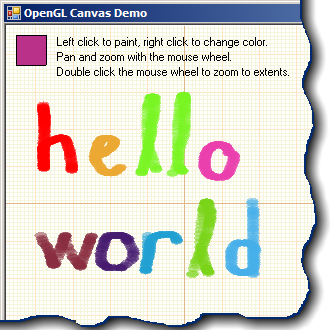
Introduction
I had recently written some code to display lots of simple 2D shapes for a finite element program. My first thought was to use GDI. However, since I had to display thousands of shapes on the screen, GDI was too slow for me. The solution came up as an OpenGL control. In this article, I will try to explain how I created a control utilizing OpenGL for a 2D shape drawing.
Using the Code
The source code includes a control named GLCanvas2D based on System.Windows.Forms.UserControl. OpenGLspecific initialization code is as follows:
GLCanvas2D::GLCanvas2D()
{
/* User control initialization code goes here
....
.... */
// Get a handle to the device context
mhDC = GetDC((HWND)this->Handle.ToPointer());
// Choose a pixel format
PIXELFORMATDESCRIPTOR pfd = {
sizeof(PIXELFORMATDESCRIPTOR), // size of the structure
1, // version
PFD_DRAW_TO_WINDOW | PFD_SUPPORT_OPENGL | PFD_DOUBLEBUFFER,
// flags
PFD_TYPE_RGBA, // pixel type
32, // color bits
0, 0, 0, 0, 0, 0, 0, 0, // RGBA bits and shifts
0, // accumulation buffer bits
0, 0, 0, 0, // accumulation buffer RGBA bits
32, // depth bits
24, // stencil bits
0, // aux bits
PFD_MAIN_PLANE, // layer type
0, // reserved
0, 0, 0 // layer masks
};
// Set the pixel format
int iPixelFormat = ChoosePixelFormat(mhDC, &pfd);
SetPixelFormat(mhDC, iPixelFormat, &pfd);
// Create the render context
mhGLRC = wglCreateContext(mhDC);
wglMakeCurrent(mhDC, mhGLRC);
}This code is called in the constructor of GLCanvas2D. The destructor deletes the render context and releases the device context.
GLCanvas2D::~GLCanvas2D()
{
wglMakeCurrent(NULL, NULL);
wglDeleteContext(mhGLRC);
ReleaseDC((HWND)this->Handle.ToPointer(), mhDC);
}I have two variables used for panning and zooming the view: a point structure containing a camera position and a zoom factor. In each paint event, the projection matrix is setup using these two variables.
// Set an orthogonal projection matrix
glMatrixMode(GL_PROJECTION);
glLoadIdentity();
glOrtho(mCameraPosition.X -
((float)ClientRectangle.Width) * mZoomFactor / 2, // Left
mCameraPosition.X +
((float)ClientRectangle.Width) * mZoomFactor / 2, // Right
mCameraPosition.Y -
((float)ClientRectangle.Height) * mZoomFactor / 2, // Bottom
mCameraPosition.Y +
((float)ClientRectangle.Height) * mZoomFactor / 2, // Top
-1.0f, // Near plane
1.0f); // Far planeCamera position and zoom factor are calculated when the user pans (by holding down the mouse wheel) or zooms (by scrolling the mouse wheel). I also needed some method of transforming coordinates from screen to model coordinates and back.
/// <summary>
/// Converts the given point from world coordinates to screen coordinates.
/// </summary>
Drawing::Point WorldToScreen(float x, float y)
{
// Move the given point to the origin, divide by the zoom factor and
// add the screen coordinates of the center point
return Drawing::Point(
(int)((x - mCameraPosition.X) / mZoomFactor) +
ClientRectangle.Width / 2,
-(int)((y - mCameraPosition.Y) / mZoomFactor) +
ClientRectangle.Height / 2);
}
/// <summary>
/// Converts the given point from screen coordinates to world coordinates.
/// </summary>
Drawing::PointF ScreenToWorld(int x, int y)
{
// Move the given point to the origin, multiply by the zoom factor and
// add the model coordinates of the center point (camera position)
return Drawing::PointF(
(float)(x - ClientRectangle.Width / 2) * mZoomFactor +
mCameraPosition.X,
-(float)(y - ClientRectangle.Height / 2) * mZoomFactor +
mCameraPosition.Y);
}GLCanvas2D exposes a Render event which is typically overridden in implementations. The control overrides theOnPaint event of the base class and raises the Render event passing a GLGraphics object as an argument.GLGraphics is similar to the System.Drawing.Graphics class. Drawing is done using the methods of theGLGraphics object.
void MyCanvas2D::Render(System::Object ^ sender, GLView::GLGraphics ^ Graphics)
{
// Draw a filled rectangle
Graphics->FillRectangle(0.0f, 0.0f, 100.0f, 50.0f, Drawing::Color::Red);
}Implementations can also use native OpenGL calls within the Render event.
void MyCanvas2D::Render(System::Object ^ sender, GLView::GLGraphics ^ Graphics)
{
// Draw a filled rectangle
glBegin(GL_QUADS);
glColor3f(1.0f, 0.0f, 0.0f);
glVertex2f(0.0f, 0.0f);
glVertex2f(100.0f, 0.0f);
glVertex2f(100.0f, 50.0f);
glVertex2f(0.0f, 50.0f);
glEnd();
}Points of Interest
If an implementation places more than one instance of GLCanvas2D on a Form, we have to make sure that OpenGLcalls are directed to the correct render context. We achieve this by calling wglMakeCurrent with the handle of our render context each time the OnPaint event is fired.
void GLCanvas2D::OnPaint(System::Windows::Forms::PaintEventArgs^ e)
{
// Save previous context and make our context current
HDC mhOldDC = wglGetCurrentDC();
HGLRC mhOldGLRC = wglGetCurrentContext();
wglMakeCurrent(mhDC, mhGLRC);
/* Drawing code goes here
....
.... */
// Restore previous context
wglMakeCurrent(mhOldDC, mhOldGLRC);
}GLView uses OpenGL vertex arrays to speed up drawing. Vertex arrays are handled internally by a customGLVertexArray class. The GLGraphics class collects vertex information using two GLVertexArray's. OneGLVertexArray is used for filled shapes. Each filled shape is converted to triangles and stored in the vertex array. A second GLVertexArray collects lines. No drawing is actually performed until the Render event ends.
System::Void Render()
{
// Create the vertex arrays on the fly
float * vp = new float[mVertices->Count * 3];
float * cp = new float[mVertices->Count * 4];
// Fill in the vertex arrays. mVertices is an internal list for collecting
// vertex position and color.
for (int j = 0; j < mVertices->Count; j++)
{
vp[j * 3] = mVertices[j].x;
vp[j * 3 + 1] = mVertices[j].y;
vp[j * 3 + 2] = mVertices[j].z;
cp[j * 4] = mVertices[j].r;
cp[j * 4 + 1] = mVertices[j].g;
cp[j * 4 + 2] = mVertices[j].b;
cp[j * 4 + 3] = mVertices[j].a;
}
// Set OpenGL vertex and color pointers to our vertex arrays
glVertexPointer(3, GL_FLOAT, 3 * sizeof(float), vp);
glColorPointer(4, GL_FLOAT, 4 * sizeof(float), cp);
// Draw the arrays
glDrawArrays(mType, 0, mVertices->Count);
// Clean up
delete[] vp;
vp = 0;
delete[] cp;
cp = 0;
}History
- 25.01.2007 - First release
- 26.04.2007 - Various bug fixes (Thanks to Jac for bug reports and suggestions)
- 05.02.2010 - Fixed a memory leak in
GLGraphics::Render




